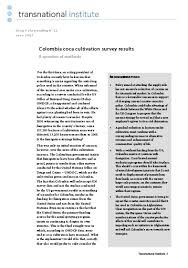Ideas into movement
Boost TNI's work
50 years. Hundreds of social struggles. Countless ideas turned into movement.
Support us as we celebrate our 50th anniversary in 2024.

Despite 2006 witnessing the most intensive use of fumigation in the country’s history, some 157,200 hectares of cultivation areas were detected, 13,200 hectares more than in 2005. Is the fumigation strategy failing?

For the first time, an acting president of Colombia recently let it be known that something is amiss regarding the anti-drug policy used in the country. When informed of the increased area under coca cultivation, according to a survey conducted by the US Office of National Drug Control Policy ONDCP, a disappointed and confused Álvaro Uribe asked whether all of the efforts against coca planting had been in vain. He had plenty of reason to wonder. Despite 2006 witnessing the most intensive use of fumigation in the country’s history, some 157,200 hectares of cultivation areas were detected, 13,200 hectares more than in 2005. Is the fumigation strategy failing?
This was only an initial reaction of concern, however, over the news of the cultivation increase. The Colombian government insists that fumigations have been effective and as proof, points to results from other surveys conducted by the United Nations Office on Drugs and Crime – UNODC, which are the only studies given credence in Colombia. The fact that Colombia will only accept UN survey data and not the studies conducted by the US government results in something of a paradox for Colombia, insofar as the funding for fumigation comes from the United States and not from the United Nations.
Even more curious is the fact that the United States, the primary funding source for the aerial spraying program, insists in continuing it, despite its own statistics. This is the third straight year in which, according to ONDCP data, areas under coca cultivation have increased. What is the explanation? Could it be that, secretly, they also would prefer to only consider the more convenient UN statistics? On the other hand, if the US only accepts its own statistics, what is the purpose of the UN surveys? Perhaps to see if Europe and the rest of the world can be convinced?
Recommendations
• Policy aimed at attacking the supply side has not ensured a reduction of cocaine on the international market. In Colombia there is a favourable consensus in support of changing current counter-narcotics policy. Colombia could take advantage of the divide between the White House and the US Congress to propose that the current strategy be revised and that a new emphasis be given to its social dimension.
• A gradual reduction in hectares under cultivation must combine with a corresponding increase in alternative revenues and enhancement of communities’ quality of life.
• With or without funding from the US, Colombia must not continue with fumigation. Coordinated manual eradication programs should take its place. This should occur within the framework of sound development projects that do not result in displacement of peasants from their lands, as occurs with the current large-scale projects, on the contrary, they would encourage peasants to remain within their regions.
• The United States government is trying to repeat the counter-narcotics model that it has used in Colombia in Afghanistan. Clear recognition on the part of the UN system, the European Union and its member nations of the counterproductive effects of this model will contribute to impeding such an initiative in Afghanistan and will aid Colombia's move towards new strategies.
Pages: 4